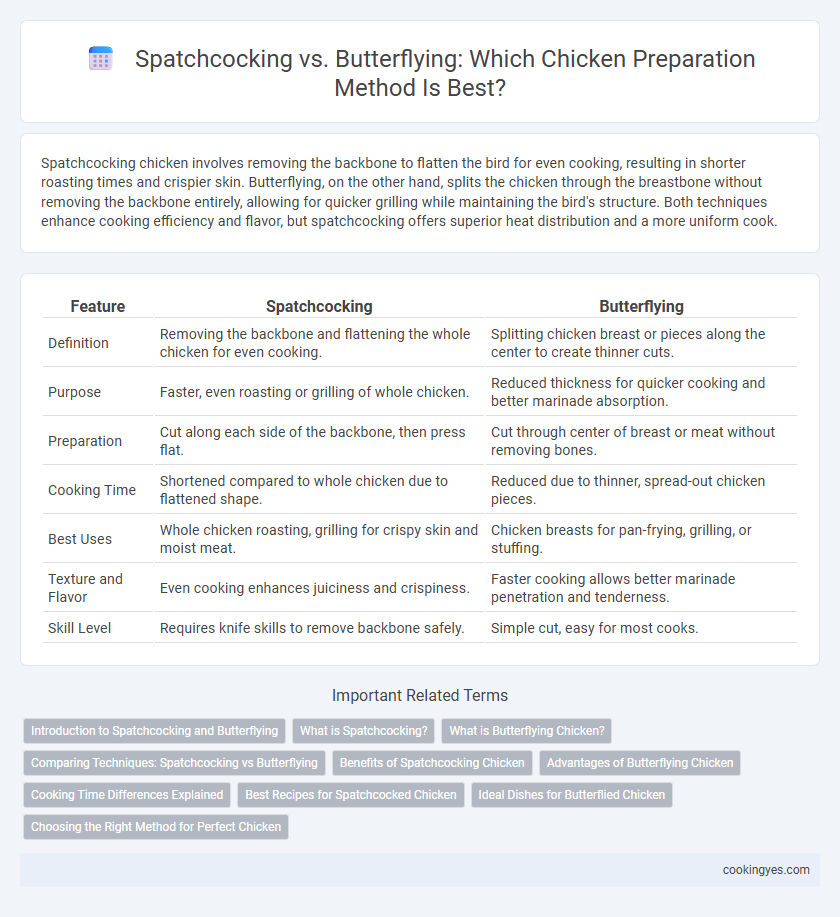Spatchcocking chicken involves removing the backbone to flatten the bird for even cooking, resulting in shorter roasting times and crispier skin. Butterflying, on the other hand, splits the chicken through the breastbone without removing the backbone entirely, allowing for quicker grilling while maintaining the bird's structure. Both techniques enhance cooking efficiency and flavor, but spatchcocking offers superior heat distribution and a more uniform cook.
Table of Comparison
| Feature | Spatchcocking | Butterflying |
|---|---|---|
| Definition | Removing the backbone and flattening the whole chicken for even cooking. | Splitting chicken breast or pieces along the center to create thinner cuts. |
| Purpose | Faster, even roasting or grilling of whole chicken. | Reduced thickness for quicker cooking and better marinade absorption. |
| Preparation | Cut along each side of the backbone, then press flat. | Cut through center of breast or meat without removing bones. |
| Cooking Time | Shortened compared to whole chicken due to flattened shape. | Reduced due to thinner, spread-out chicken pieces. |
| Best Uses | Whole chicken roasting, grilling for crispy skin and moist meat. | Chicken breasts for pan-frying, grilling, or stuffing. |
| Texture and Flavor | Even cooking enhances juiciness and crispiness. | Faster cooking allows better marinade penetration and tenderness. |
| Skill Level | Requires knife skills to remove backbone safely. | Simple cut, easy for most cooks. |
Introduction to Spatchcocking and Butterflying
Spatchcocking and butterflying are two popular techniques for preparing whole chicken by removing the backbone to allow the bird to lay flat for even cooking. Spatchcocking involves removing the backbone completely and pressing the bird flat, which reduces cooking time and promotes crispier skin. Butterflying, while similar, typically refers to slicing the chicken open without fully removing the backbone, making it easier to marinate and grill.
What is Spatchcocking?
Spatchcocking is a method of preparing chicken by removing the backbone and flattening the bird for even cooking and faster roasting. This technique exposes more surface area to heat, resulting in crispy skin and juicy meat. Unlike butterflying, which often splits the chicken partially, spatchcocking fully opens the bird for optimal heat distribution.
What is Butterflying Chicken?
Butterflying chicken involves slicing the bird along the backbone and flattening it out without removing the backbone entirely, creating a larger, thinner piece that cooks more evenly and quickly. This technique enhances heat distribution across the chicken, resulting in juicier meat and crispier skin compared to traditional roasting. Unlike spatchcocking, which removes the backbone completely, butterflying maintains some structural integrity while improving cooking performance.
Comparing Techniques: Spatchcocking vs Butterflying
Spatchcocking involves removing the backbone and flattening the chicken for even cooking, while butterflying simply splits the bird without fully flattening it, leading to less uniform heat distribution. Spatchcocked chickens roast faster and crisp more evenly due to their flattened shape, making them ideal for grilling or roasting whole. Butterflying maintains more of the bird's original structure, which can preserve moisture but may require longer cooking times and careful temperature control.
Benefits of Spatchcocking Chicken
Spatchcocking chicken involves removing the backbone and flattening the bird, resulting in more even cooking and significantly reduced roasting time compared to traditional methods. This technique enhances skin crispiness due to better heat exposure and allows for consistent seasoning across the entire chicken surface. Home cooks and professionals prefer spatchcocking for juicier meat and improved presentation, making it a highly efficient preparation method.
Advantages of Butterflying Chicken
Butterflying chicken offers faster and more even cooking by flattening the bird, which reduces cooking time and enhances heat distribution. This technique increases surface area, allowing for better seasoning absorption and a crispier skin texture. Butterflied chicken is ideal for grilling and roasting, resulting in juicy, tender meat with consistent doneness throughout.
Cooking Time Differences Explained
Spatchcocking chicken involves removing the backbone and flattening the bird, which allows for more even heat distribution and significantly reduces cooking time compared to traditional roasting methods. Butterflying, which typically means splitting the chicken along the breast without removing the backbone, also helps with faster cooking but is less effective than spatchcocking in achieving uniform doneness. The flattened shape of a spatchcocked chicken exposes more surface area, resulting in quicker, more efficient heat penetration and juicier meat.
Best Recipes for Spatchcocked Chicken
Spatchcocking chicken involves removing the backbone and flattening the bird, allowing for even cooking and crispy skin, making it ideal for recipes like garlic-herb roast or lemon-thyme grilled chicken. This method enhances flavor penetration and reduces cooking time compared to traditional roasting. Popular spatchcocked chicken recipes often feature marinades with bold spices and fresh herbs to maximize juiciness and depth of taste.
Ideal Dishes for Butterflied Chicken
Butterflied chicken, with its even thickness and quick cooking time, is ideal for grilling, roasting, and pan-searing, providing a juicy and evenly cooked result. Popular dishes include grilled herb chicken, lemon garlic roasted chicken, and spicy pan-seared chicken breasts, where the flattened shape ensures uniform heat distribution. This technique is especially favored for recipes requiring a crispy skin and tender meat without overcooking.
Choosing the Right Method for Perfect Chicken
Spatchcocking involves removing the backbone and flattening the chicken for even cooking and crispy skin, ideal for grilling or roasting whole birds quickly. Butterflying splits the chicken open without removing the backbone, providing a flatter shape but less surface area for crispiness, best suited for pan-frying or faster cooking times. Selecting spatchcocking or butterflying depends on the cooking method and desired texture, with spatchcocking preferred for uniform heat distribution and butterflying favored for quicker, more manageable portions.
Spatchcocking vs Butterflying for chicken preparation Infographic

 cookingyes.com
cookingyes.com